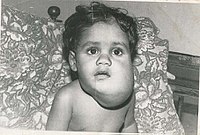
Photo from wikipedia
OBJECTIVE Studies summarizing the outcome of first-trimester septated cystic hygroma are generally based on small studies or from multiple centers with limited ascertainment. We reviewed the natural history of a… Click to show full abstract
OBJECTIVE Studies summarizing the outcome of first-trimester septated cystic hygroma are generally based on small studies or from multiple centers with limited ascertainment. We reviewed the natural history of a large cohort of such cases from a single tertiary referral center, with the aim being to establish contemporary outcome data, particularly in the setting of normal karyotype. METHODS A retrospective cohort study from 2007 to 2017 was conducted at a single tertiary referral prenatal diagnosis center. Data were analyzed from a prospectively collated fetal anomaly database. Search terms were "increased nuchal translucency (NT)," "cystic hygroma," and "septated cystic hygroma." All cases were confirmed to have NT >3 mm with septations. Cases of simple increased NT without septations were excluded. RESULTS During the study period, over 110,000 pregnancies were delivered at our center, resulting in 410 cases of septated cystic hygroma diagnosed prior to 14 weeks' gestation. Pregnancy outcome was obtained in 99% (405/410) of cases, with detailed pathology outcome available in 92% (378/410). A total of 87% (351/405) underwent invasive prenatal testing, and postnatal chromosome status was established in further 27 cases. A total of 61% (230/378) had abnormal chromosomal status. Of the 39% (148/378) with normal chromosomal status, only 13% (19/148) had a significant structural fetal abnormality, which included 7 cardiac and 12 noncardiac abnormalities. Overall, the perinatal loss was 62% (253/405). The total survival rate in the setting of euploid cystic hygroma without structural abnormality was 84% (108/129). CONCLUSIONS Counseling regarding outcomes in the setting of first-trimester septated cystic hygroma initially focuses on the strong likelihood of an abnormal karyotype, which occurs in 61% of cases. However, once fetal chromosomal abnormality is excluded, our results demonstrate only a 13% incidence of major structural fetal abnormality, which appears significantly less than previously reported. Normal fetuses have a 77% survival rate. These data represent the largest single-center study of first-trimester cystic hygroma with complete outcome data and therefore will be useful for contemporary patient counseling. Such counseling can be more positive than previously expected, once chromosomal abnormality is first excluded.
Journal Title: Fetal diagnosis and therapy
Year Published: 2021
Link to full text (if available)
Share on Social Media: Sign Up to like & get
recommendations!